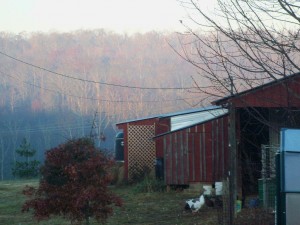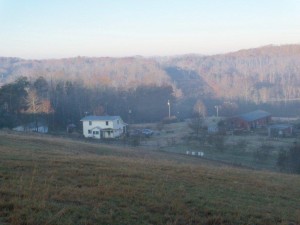The old man who works our dump has a wreath on his work shed and four cars parked at his door. As I unload my garbage the visitors begin to spill out his door calling back over their shoulders a “Merry Christmas” to the man they had all come to see.
In the pasture across the road from the dump are twenty ewes grazing in as pretty a scene as you could paint. Heading back down the road I pull up to a stop sign at the former Galyon’s General Store. I glance over at the parking lot. Two men straight out of central casting, clothed in overalls and with beards down to the waist, stand behind sawhorse tables laden with citrus for sale. It is Christmas time in Paint Rock.
From Paint Rock to Cedar Fork: it is a hardscrabble valley we share. Most homes are a modest eight hundred to twelve hundred square feet. A few of our neighbors have clearly spent their ‘holiday” money at Wal-Mart on inflatable snowmen. More homes are simply decorated with wreaths and a few lights. All have a steady plume of smoke coming out of the chimney. The homes of the older residents all seem to have an extra car or two. Family brought home for the season.
A few visits around the valley to share some of our farm’s bounty and then it is time for a last minute visit to the Farmer’s co-op. Santa rocks gently in one of the rockers for sale up front. It is a downtime for him as he waits for another kid to show up, so he busily texts on his Blackberry. I crack to the clerk that I see no reindeer. He replies, “This Santa arrived in an old Dodge truck”.
Christmas Eve and all is ready. Cindy is home with her family and returns tomorrow on Christmas Day. A final visit later today with Mr. Kyle and a shared glass of Mayfield’s finest. Then perhaps Adrienne will walk up the hill with her bottle of warm gluhwein to toast the evening and an hour or two of conversation before she heads back down to her family.
Midnight, I’ll stroll out to the cattle in the barn to see if they kneel and speak, before turning into my bed.
Merry Christmas!


